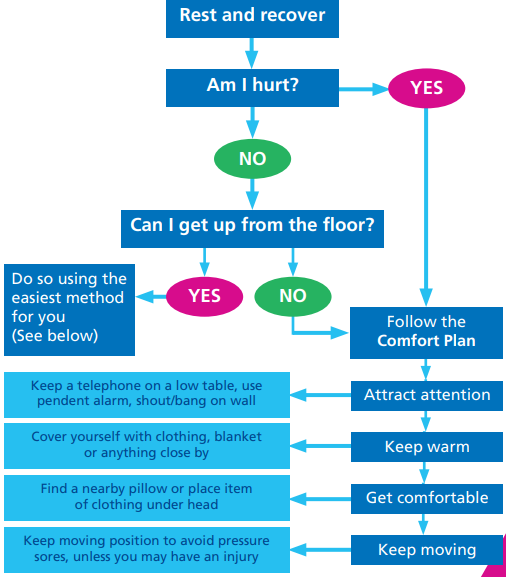Download and print as a PDF (185kB pdf)
On this page
Who is this leaflet for?
This leaflet is for people who have gone through limb loss. It offers guidance about:
• how to try and prevent a fall
• what to do if a fall occurs
• ways to get up off the floor.
What can you do to prevent a fall?
- Being aware that the feeling of still having your limb (phantom limb) may cause you to attempt to try and stand on that leg, even when not wearing a prosthesis.
- Making sure you drink enough water to avoid dehydration which could lead to feeling dizzy or unwell.
- Making sure that you keep active. Inactivity can lead to weaker muscles and poor balance.
- Making sure you don’t rush, especially to the toilet. If you have any continence problems please contact your GP.
- Making sure that any medication you are on is regularly checked, especially if you start to experience any dizziness when standing up.
- Placing your most frequently used items in easy to reach places.
- Making sure there is a good lighting, no loose rugs or wet or uneven floors and minimise any clutter around your home.
- Talking to you GP about any onward referrals if you are feeling unsteady or have lost your confidence. Local services often include specific falls physiotherapy.
What should you do if you fall?
If you fall and are unable to get up off the floor, try and keep yourself:
• warm
• comfortable
• moving.

How do I get up from the floor?
People with any level amputation could try this technique:
1. Place a low stool or cushion in front of a chair, which has its back to the wall (or will not move).
2. Position your bottom in front of it.
3. Bend your remaining leg and place your foot flat on the floor.
4. Place your hands behind you on the cushion / stool.
5. Push with your leg and at the same time use your hands to lift your bottom from the floor onto the cushion / stool.
6. Use the same technique to lift yourself up onto the chair.
7. This technique can be done in several stages if needed or straight up from the floor if you have enough strength.
8. You should have been shown these techniques by your physiotherapist. If you would like further practice please contact the Prosthetic Centre.
If you have a below knee amputation you could try this technique::
1. Stay calm and get your breath back.
2. When you are ready roll to one side.
3. Using your arms push yourself up into side sitting.
4. Using your arms push yourself up onto your knees.
5. Crawl to the nearest piece of sturdy furniture (something that is unlikely to move if you put your weight onto it).
6. Put your hands onto the piece of furniture and bring your remaining foot forwards and place the foot flat on the floor.
7. Push through your arms and leg to push yourself up, turn and sit down.
Is there anything else I should do?
- Contact your Prosthetist so that your prosthesis can be checked if necessary.
- If you notice problems e.g. damage to your skin, pain (in a joint) make an appointment to see your GP.
- If your fall has affected your walking or you are worried about your balance then please contact the Prosthetic Centre physiotherapist.
Other advice
Walking aids
• Keep a check on wear of rubber bottoms on sticks, crutches or frames. They should have grooves and NOT be smooth in appearance.
• Be careful where you leave your walking aid. It could be tripped over.
• Do not use another person’s walking aid. It may not be suitable for you.
Wheelchair use
- Make sure that if you need it, your wheelchair is easily accessible at night.
- Make sure you put your wheelchair brakes on when getting in and out of your wheelchair.
- Always move footplates out of the way when transferring from / to the wheelchair.
Footwear
- Wear shoes / slippers that are comfortable, supportive, fit properly and have non-slip soles. Ideally shoes with a back.
- If you wear a prosthesis make sure you wear a shoe or slipper with it.
- All footwear used should have been set by your prosthetist on the prosthesis so the limb is lined up correctly.
- Consider getting a pendent alarm or mobile phone to keep on your person.
- Place cushions and blankets around the house at floor level so that, if you do fall, you can keep warm and comfortable while waiting for help.
- Ensure that your home is well lit.
- Consider keeping the hall light on at night in case you need to get up to go to the toilet, and always use your bedside light when getting up at night.
- Clear away clutter and rugs, especially in the hall / landing and doorways.
- If you need any further information or advice then please contact your occupational therapist or physiotherapist at the Prosthetic Centre.
Useful contacts
Occupational Therapy
Royal Sussex County Hospital, Eastern Road, Brighton, BN2 5BE
01273 696955
Ext. 67467
Sussex Rehabilitation Centre (Limb Centre)
Brighton General Hospital, Elm Grove, Brighton BN2 3EX
Limbless Association
Provide support to amputees and the limb-loss community. Advice on managing as an amputee and exercise opportunities.
Unit 10, Waterhouse Business Centre, 2 Cromar Way, Chelmsford, Essex CM1 2QE
Helpline
0800 644 0185
This leaflet is intended for patients receiving care in Brighton and Hove or Haywards Heath.
University Hospitals Sussex NHS Foundation Trust Disclaimer: The information in this leaflet is for guidance purposes only and is in no way intended to replace professional clinical advice by a qualified practitioner.